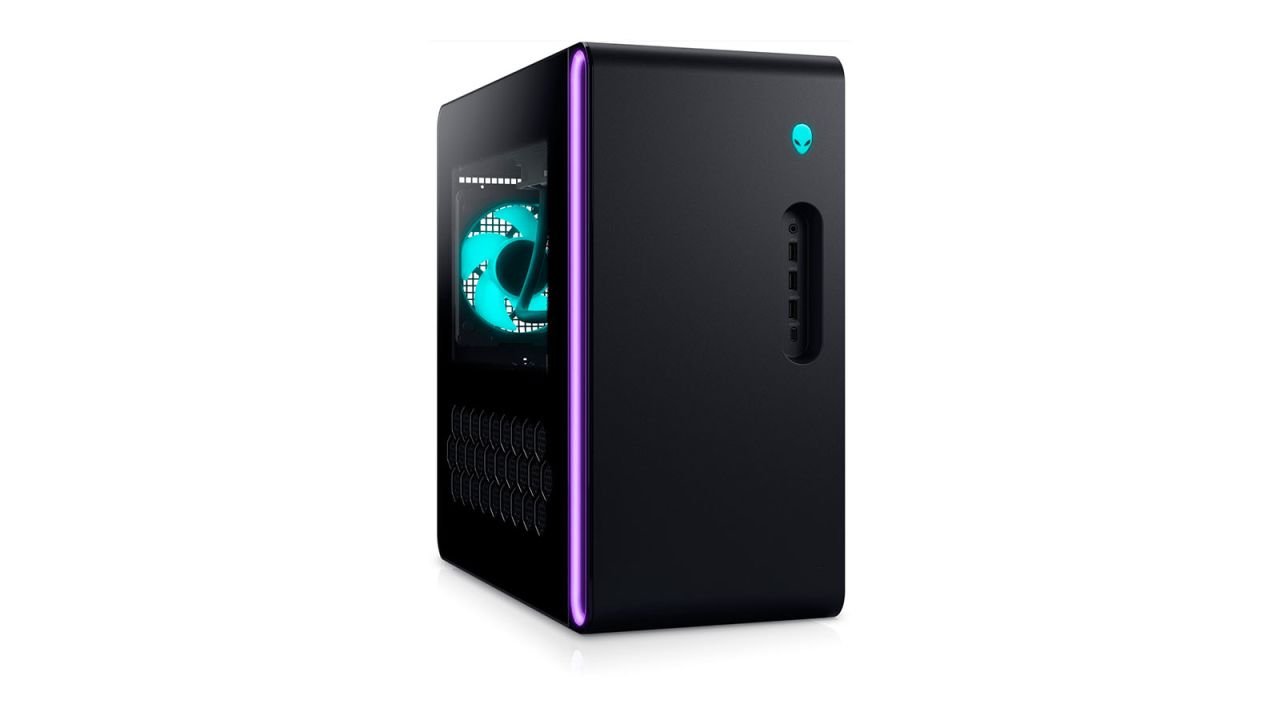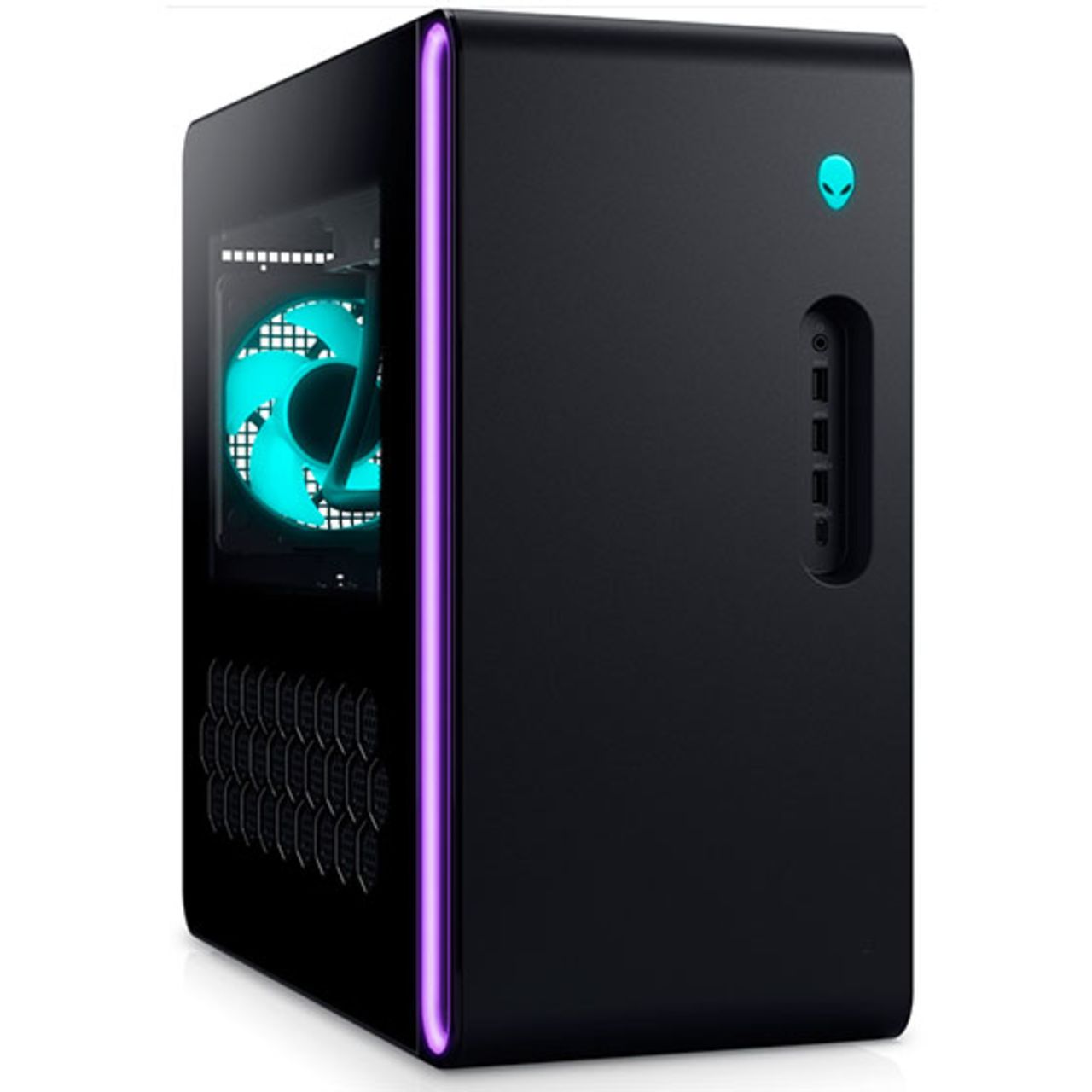Dell’s Alienware line of gaming devices just got a new entry in the form of the Alienware Aurora R16. The gaming desktop boasts a smaller housing, improved cooling, and current-gen specs at a price that’s almost too good to be true.
I’ve been putting the R16 through its paces and have come away with a renewed appreciation for PC gaming and the versatility it offers.
With systems starting at $1,749, you can configure the R16 to fit your gaming needs. Here’s what it’s been like using an R16 with middle-of-the-line specs.
If you’re looking for top-level gaming PC performance within a small, attractive and relatively affordable package — one that you can upgrade over time — the Alienware Aurora R16 is one of the best gaming PCs we’ve tested.
Small and quiet, just the way it should be

According to Alienware, the R16 is roughly 40% smaller than its predecessor. In total, it measures 16.5 x 18.05 x 7.76 inches, and weighs just under 34 pounds. The company wanted to decrease the tower’s overall size in order to accommodate more gamers, especially those with smaller desks or gaming spaces.
One potential issue with stuffing PC hardware in a smaller housing is dealing with heat, and in turn, fan noise. In the unit I received for testing, there’s a 120mm front fan, and a 240mm top-mounted heat exchange that drives the CPU liquid cooling in combination with two 120mm fans along the top of the housing. There’s another 120mm fan with RGB lighting at the rear of the housing.
Looking at the R16 from the side through the tinted glass panel, you wouldn’t suspect there’s all that cooling gear inside — until the rear fan’s RGB lights turn on, adding just enough light to the enclosure for you to see there’s plenty of hardware packed into the case.

The front of the tower has an RGB version of the iconic Alienware logo, along with three USB 3.2 Gen 1 ports, one of which has PowerShare tech, a USB-C 3.2 Gen 2 with PowerShare and a 3.5mm headphone jack stacked vertically just below the power button.
The left side of the housing has a removable glass panel. The bottom third of the panel has honeycomb cutouts to help with airflow, while the rest of it appears slightly tinted, allowing you to see inside the housing while simultaneously adding to the mystery of what’s inside.
The rear of the case, of course, is where you’ll find the bulk of the ports for the PC. Without getting too carried away, there’s a total of six USB ports of varying speeds, along with two USB-C ports of varying speeds, a 2.5Gbit Ethernet port and various audio connections. The GPU’s video connections are also present, of course, with the RTX 4070 giving you 3 DisplayPort connections and a lone HDMI option.

What I found most impressive during my time testing is just how quiet this system is. After setting it up, I spent a few hours running through our standard onslaught of benchmarks which are designed to push the system to its limits, and typically trigger the fans at high for long periods of time.
Instead, what I experienced was a system that was mostly silent, with an occasional outburst of the fans to get the components back down to temp.
Even when I started actually gaming, the fans were audible, but they weren’t overpowering to the point I felt like I needed to switch to headphones instead of my speakers.
Alienware is touting that the R16 is quiet, and it’s an impressively accurate statement.

Alienware plans on offering the new R16 in various configurations. The base configuration will include an Intel Core i7–13700 processor, 16GB of memory, 1TB SSD storage and an Nvidia GeForce RTX 4070 graphics card for $1,749. You can, of course, kit out that base build.
The review build I received has an Intel Core i7–13700, 32GB of DDR5 memory, 1TB SSD storage and an RTX 4070 GPU, with a clear side panel, optional 240mm liquid cooling and a 1000W Platinum-rated power supply.
This is the first time I’ve been able to test any of Nvidia’s 40-series GPUs, so I was excited to see what it’d offer over my personal gaming PC — which by now is several years old and starting to show its age.
After initially setting up the R16, I ran it through a series of benchmarks to objectively measure its performance across daily computing tasks and in specific games. Those tests include PCMark 10’s Extended, Geekbench 5 and 6, Shadow of the Tomb Raider and Dirt 5.
All tests were run at 2560 x 1440, the native resolution of the Alienware 27 Gaming Monitor I used for testing. Some tests were repeated at 1080p to get an idea of performance for those who haven’t made the jump to a more expensive monitor yet.
The results? The R16 nearly outperforms every gaming PC we’ve tested at CNN Underscored.
| Processor |
Intel Core i7013700 |
Intel Core i7–12700KF |
Intel Core i7–11700K |
|---|---|---|---|
| Graphics |
Nvidia RTX 4070 |
Nvidia RTX 3080 |
Nvidia RTX 3080 |
| Geekbench 5 multi-core performance |
13,494 |
15,272 |
10,348 |
| Shadow of the Tomb Raider (1080p, max settings) |
182 fps |
185 fps |
170 fps |
| Dirt 5 (1080p, max settings) |
170 fps |
114 fps |
160 fps |
As you can see, the Alienware Aurora R13 outperforms the R16 in the Tomb Raider and multi-core performance for Geekbench 5, but not by much.
But using apps to calculate numbers and performance is only part of the story, and to some, not the real story. Daily use and actually gaming on the R16 is where it’s delivered everything I could have hoped it would.
For my testing, I started playing Call of Duty: Warzone 2 after a long break and immediately felt right at home — not only in terms of familiarity with the game, but with the performance that the R16 provides.
I used the Xbox overlay tool to monitor the computer’s frames-per-second (fps) and provide an average over the last 60 seconds. During the course of a match, I would randomly take note of the average fps and then I averaged those numbers. The result? With graphics settings turned up to extreme at 1440p resolution, the R16 averaged a very smooth 104 fps.
If I turned the resolution down to 1080p and used the same method to monitor performance, I saw an average of 134 fps. But what’s more important than just the frame rates is that the game itself looked and felt great. The R16 was responsive to my movements and commands.
There’s no reason the R16 won’t be able to provide the same level or better of performance for any of the best PC games. It’s a workhorse, no doubt.
Here’s something that’ll boggle your mind. I know it did mine. The configuration I tested comes in at $1,899. If you go to Alienware’s website and configure the Aurora R15 with similar specs, it’ll cost you $2,749.
That’s nearly a $1,000 difference for virtually the same internal configuration, but a different housing that has more RGB lighting on the outside. There’s more to it than that, of course, but it just goes to show that you don’t have to spend a ton to get a reliable, performant system.
And if you decide that the build you start with isn’t enough for your use, or it ages faster than you’d like, Alienware made it easy to access all of the internals and swap out or add new parts on your own. For example, there’s a spare m2 SSD slot that’s just waiting for expanded storage with a couple of turns of the screwdriver. And you can swap out the graphics card a couple of years from now, without the need for any tools.

With the Aurora R16, you have three dedicated areas where you can control the RGB lighting. There’s the power button on the front, a vertical AlienFX stadium on the left side of the housing that’s also used to draw air into the housing, and then the RGB fan at the rear of the case.
You can control all of those lights using Alienware Command Center 6, which is making its desktop debut with the release of the Aurora 16. And while the stadium light itself gives off plenty of ambiance, overall the enclosure looks and feels dark. I’d love to have the option to add some lights to the RAM, or even on the CPU’s liquid cooler to add some more personality and flair to the system.
Because, as we all know, more RGB means more frames per second, which translates into being a better gamer.
Admittedly, my exposure to current-gen gaming desktops is limited. I’m still using an older AMD model with an RTX 3070 Super in it, so my being impressed by the performance of the Aurora R16 is expected.
However, looking at similarly spec’d systems, the Aurora R16 checks all of the right boxes in terms of hardware, performance and pricing. Not to mention, the redesigned enclosure helps save some space while also keeping the system running cool and quiet.
If you’re looking for a new desktop gaming PC and those are the same boxes you need a system to check, then the R16 is the one for you. However, if you’re looking for alternatives, be ready to spend some extra cash for a system with similar specs. For instance, NZXT’s $2,400 Player: Three build is one worth checking out, as is the $2,500 Corsair Vengeance i7400.








